Miele H 4431 PYRO User Manual
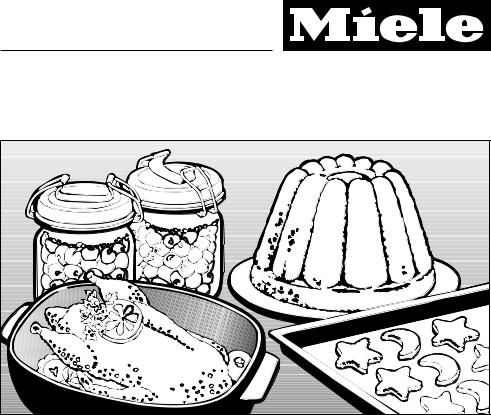
Operating instructions
Pyrolytic ovens |
H 4331, H 4431 |
To avoid the risk of accidents or damage to the appliance, it is essential to read these instructions
before it is installed and used for the first time.
G
M.-Nr. 06 513 800
2

Contents
Description of the appliance. . . . . . . . . . . . . . . . . . . . . . . . . . . . . . . . . . . . . . . . . 5 Features . . . . . . . . . . . . . . . . . . . . . . . . . . . . . . . . . . . . . . . . . . . . . . . . . . . . . . . . . . 6 Accessories . . . . . . . . . . . . . . . . . . . . . . . . . . . . . . . . . . . . . . . . . . . . . . . . . . . . . . . 8 Baking tray, grill pan and rack . . . . . . . . . . . . . . . . . . . . . . . . . . . . . . . . . . . . . . 8 Roasting filter . . . . . . . . . . . . . . . . . . . . . . . . . . . . . . . . . . . . . . . . . . . . . . . . . . . 8 Slide opener . . . . . . . . . . . . . . . . . . . . . . . . . . . . . . . . . . . . . . . . . . . . . . . . . . . . 8 Anti-splash tray . . . . . . . . . . . . . . . . . . . . . . . . . . . . . . . . . . . . . . . . . . . . . . . . . . 9 Handle . . . . . . . . . . . . . . . . . . . . . . . . . . . . . . . . . . . . . . . . . . . . . . . . . . . . . . . . 9
Caring for the environment . . . . . . . . . . . . . . . . . . . . . . . . . . . . . . . . . . . . . . . . . 10
Warning and Safety instructions . . . . . . . . . . . . . . . . . . . . . . . . . . . . . . . . . . . . 11
Safety feature . . . . . . . . . . . . . . . . . . . . . . . . . . . . . . . . . . . . . . . . . . . . . . . . . . . . 16
Before using for the first time . . . . . . . . . . . . . . . . . . . . . . . . . . . . . . . . . . . . . . . 17 Set the time of day for the first time . . . . . . . . . . . . . . . . . . . . . . . . . . . . . . . . . . . . 17 Cleaning and heating up for the first time . . . . . . . . . . . . . . . . . . . . . . . . . . . . . . . 18
Controls . . . . . . . . . . . . . . . . . . . . . . . . . . . . . . . . . . . . . . . . . . . . . . . . . . . . . . . . 19 Programme selector. . . . . . . . . . . . . . . . . . . . . . . . . . . . . . . . . . . . . . . . . . . . . . . . 19 Display . . . . . . . . . . . . . . . . . . . . . . . . . . . . . . . . . . . . . . . . . . . . . . . . . . . . . . . . . . 19 Multi-function selector with turn and press mechanism . . . . . . . . . . . . . . . . . . . . 20
Functions and symbols in the display . . . . . . . . . . . . . . . . . . . . . . . . . . . . . . . . 21
Operating sequence . . . . . . . . . . . . . . . . . . . . . . . . . . . . . . . . . . . . . . . . . . . . . . 22
Changing the time of day . . . . . . . . . . . . . . . . . . . . . . . . . . . . . . . . . . . . . . . . . . 23
To set the minute minder. . . . . . . . . . . . . . . . . . . . . . . . . . . . . . . . . . . . . . . . . . . 24
Description of the oven systems . . . . . . . . . . . . . . . . . . . . . . . . . . . . . . . . . . . . 25
Using the oven . . . . . . . . . . . . . . . . . . . . . . . . . . . . . . . . . . . . . . . . . . . . . . . . . . . 27 Programme selector. . . . . . . . . . . . . . . . . . . . . . . . . . . . . . . . . . . . . . . . . . . . . . . . 27 Selecting a temperature. . . . . . . . . . . . . . . . . . . . . . . . . . . . . . . . . . . . . . . . . . . . . 28 Altering the temperature . . . . . . . . . . . . . . . . . . . . . . . . . . . . . . . . . . . . . . . . . . 28 Using the oven. . . . . . . . . . . . . . . . . . . . . . . . . . . . . . . . . . . . . . . . . . . . . . . . . . . . 29 Fan run-on. . . . . . . . . . . . . . . . . . . . . . . . . . . . . . . . . . . . . . . . . . . . . . . . . . . . . 30 Rapid heat-up . . . . . . . . . . . . . . . . . . . . . . . . . . . . . . . . . . . . . . . . . . . . . . . . . . . . 30 To switch "Rapid heat-up" off . . . . . . . . . . . . . . . . . . . . . . . . . . . . . . . . . . . . . . 31 Pre-heating the oven . . . . . . . . . . . . . . . . . . . . . . . . . . . . . . . . . . . . . . . . . . . . . . . 31
Entering a cooking duration . . . . . . . . . . . . . . . . . . . . . . . . . . . . . . . . . . . . . . . . 32 Symbols in the display . . . . . . . . . . . . . . . . . . . . . . . . . . . . . . . . . . . . . . . . . . . 33 Using the residual heat-Energy-save function . . . . . . . . . . . . . . . . . . . . . . . . . 34 At the end of the cooking duration . . . . . . . . . . . . . . . . . . . . . . . . . . . . . . . . . . 34 Switching off automatically . . . . . . . . . . . . . . . . . . . . . . . . . . . . . . . . . . . . . . . . . . 35
3

Contents
Switching on and off automatically . . . . . . . . . . . . . . . . . . . . . . . . . . . . . . . . . . . . 36 To check and change an entered time . . . . . . . . . . . . . . . . . . . . . . . . . . . . . . . . . 37 To delete a set time . . . . . . . . . . . . . . . . . . . . . . . . . . . . . . . . . . . . . . . . . . . . . . . . 37
System lock . . . . . . . . . . . . . . . . . . . . . . . . . . . . . . . . . . . . . . . . . . . . . . . . . . . . . 38
Safety lock . . . . . . . . . . . . . . . . . . . . . . . . . . . . . . . . . . . . . . . . . . . . . . . . . . . . . . 39
Altering oven settings v . . . . . . . . . . . . . . . . . . . . . . . . . . . . . . . . . . . . . . . . . . 41
Baking . . . . . . . . . . . . . . . . . . . . . . . . . . . . . . . . . . . . . . . . . . . . . . . . . . . . . . . . . . 45
Baking chart . . . . . . . . . . . . . . . . . . . . . . . . . . . . . . . . . . . . . . . . . . . . . . . . . . . . . 48
Roasting . . . . . . . . . . . . . . . . . . . . . . . . . . . . . . . . . . . . . . . . . . . . . . . . . . . . . . . . 50
Roasting chart . . . . . . . . . . . . . . . . . . . . . . . . . . . . . . . . . . . . . . . . . . . . . . . . . . . 52
Grilling . . . . . . . . . . . . . . . . . . . . . . . . . . . . . . . . . . . . . . . . . . . . . . . . . . . . . . . . . 53
Grill chart . . . . . . . . . . . . . . . . . . . . . . . . . . . . . . . . . . . . . . . . . . . . . . . . . . . . . . . 55
Defrosting . . . . . . . . . . . . . . . . . . . . . . . . . . . . . . . . . . . . . . . . . . . . . . . . . . . . . . . 56
Cooking. . . . . . . . . . . . . . . . . . . . . . . . . . . . . . . . . . . . . . . . . . . . . . . . . . . . . . . . . 57 Gentle bake . . . . . . . . . . . . . . . . . . . . . . . . . . . . . . . . . . . . . . . . . . . . . . . . . . . . . . 57
Cleaning and care . . . . . . . . . . . . . . . . . . . . . . . . . . . . . . . . . . . . . . . . . . . . . . . . 58 Appliance front and control panel . . . . . . . . . . . . . . . . . . . . . . . . . . . . . . . . . . . . . 58 Accessories . . . . . . . . . . . . . . . . . . . . . . . . . . . . . . . . . . . . . . . . . . . . . . . . . . . . . . 60 Baking tray, grill pan, anti-splash tray (if fitted), racks and runners . . . . . . . . . 60 Roasting filter . . . . . . . . . . . . . . . . . . . . . . . . . . . . . . . . . . . . . . . . . . . . . . . . . . 60 PerfectClean . . . . . . . . . . . . . . . . . . . . . . . . . . . . . . . . . . . . . . . . . . . . . . . . . . . . . 61 Oven interior . . . . . . . . . . . . . . . . . . . . . . . . . . . . . . . . . . . . . . . . . . . . . . . . . . . . . 63 Pyrolytic cleaning of the oven interior. . . . . . . . . . . . . . . . . . . . . . . . . . . . . . . . 63 To remove the oven door . . . . . . . . . . . . . . . . . . . . . . . . . . . . . . . . . . . . . . . . . . . . 66 To dismantle the oven door. . . . . . . . . . . . . . . . . . . . . . . . . . . . . . . . . . . . . . . . 67 To refit the door . . . . . . . . . . . . . . . . . . . . . . . . . . . . . . . . . . . . . . . . . . . . . . . . . . . 69 To remove the runners . . . . . . . . . . . . . . . . . . . . . . . . . . . . . . . . . . . . . . . . . . . . . . 70
Problem solving guide. . . . . . . . . . . . . . . . . . . . . . . . . . . . . . . . . . . . . . . . . . . . . 71
After sales service . . . . . . . . . . . . . . . . . . . . . . . . . . . . . . . . . . . . . . . . . . . . . . . . 75
Extra accessories . . . . . . . . . . . . . . . . . . . . . . . . . . . . . . . . . . . . . . . . . . . . . . . . 76
Electrical connection UK, IRL, ZA . . . . . . . . . . . . . . . . . . . . . . . . . . . . . . . . . . . 78
Electrical connection AUS, NZ . . . . . . . . . . . . . . . . . . . . . . . . . . . . . . . . . . . . . . 80
Installing the oven . . . . . . . . . . . . . . . . . . . . . . . . . . . . . . . . . . . . . . . . . . . . . . . . 81
4

Description of the appliance
Control panel *
a Programme selector, display
bMulti-function selector with turn and press mechanism, Display
Oven interior
cDoor contact switch,
Door lock for pyrolytic operation
dHeating element for top heat and grilling with roof liner
e Air inlet for fan
f Side runners with 4 shelf levels g Oven door
* style will depend on model
5

Description of the appliance
Features
Electronic controls
In addition to operating the various cooking programmes to bake, roast and grill the electronic controls also offer the following features:
–Clock display
–Minute minder
–Timer to automatically switch cooking programmes off, or on and off with automatic use made of residual heat
–Settings can be customised.
Safety features
You can activate a system lock, to prevent the appliance being used unintentionally. See "System lock" for details.
Safety switch-off is triggered automatically if the oven is operated for an unusually long period of time.
The period of time will depend on the particular oven function being used. The oven will switch off automatically and "F 55" will appear in the display. The oven can be used again immediately after switching it off and back on.
Cooling system
As soon as the oven is switched on, a cooling fan is automatically engaged. The cooling fan mixes hot air from the oven cavity with cool room air before venting it out into the kitchen through vents located between the appliance door and the control panel.
The cooling fan will continue to run for a while after the oven has been switched off to prevent any humidity building up in the oven, on the control panel or on the oven housing unit.
When the temperature in the oven has fallen sufficiently, the cooling fan will switch off automatically.
Pyrolytic self-cleaning programme
The oven interior can be kept clean by using the Pyrolytic . cleaning programme.
This programme heats the oven interior up to 460 °C. Any residual soiling is broken down and reduced to ash by the high temperatures.
For safety reasons the door is locked at the beginning of the pyrolytic programme.
This oven offers three programme durations for pyrolytic cleaning.
–PY 1 lasting approx. 2 hours 15 mins
–PY 2 lasting approx. 2 hours 35 mins
–PY 3 lasting approx. 2 hours 55 mins
For safety reasons the door will remain locked until the temperature in the oven cavity has dropped below 280 °C.
See "Cleaning and care" for more information.
6

Description of the appliance
PerfectClean treated surfaces
The following surfaces are all treated with PerfectClean enamelling:
–Runners
–Baking tray
–Grill pan
–Rack
PerfectClean enamelled surfaces have very good anti-stick properties and are much easier to keep clean than conventional enamel, if cleaned regularly.
See "Cleaning and care" for more information.
Door contact switch
There is a door contact switch located centrally underneath the control panel. If the door is opened during operation, the door contact switch causes the oven heating, and the fan, depending on which oven function is operating, to switch off.
This helps reduce the amount of heat lost from the oven cavity, e.g. when checking food.
Vented oven door
The oven door is made up of a total of four panels. There is an opening at the top and bottom of these.
During operation cool air is passed through the oven door to keep the outer panel cool and safe to touch.
If necessary the oven door can be dismantled for cleaning. See "Cleaning and Care".
Retractable controls
All controls are retractable.
Press them to release or retract them.
Energy efficiency rating according to EN 50304
These appliances are rated energy efficiency class A in accordance with EN 50304. Tests were carried out using Gentle bake.
7
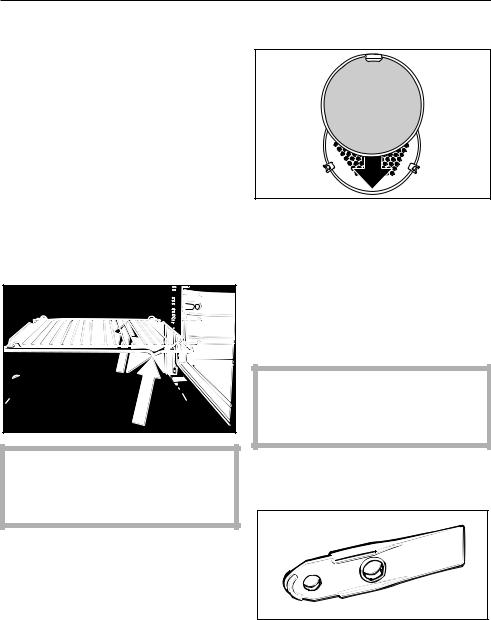
Description of the appliance
Accessories |
Roasting filter |
The following accessories are supplied with this oven.
These and other accessories are also available to order from the Miele Spare Parts Dept. or your Miele Dealer. See "Extra accessories" further on in this booklet for more details.
Baking tray, grill pan and rack
The baking tray, grill pan and rack are fitted with non-tip safety notches which prevent them being pulled right out when they only need to be partially pulled out.
When pushing the tray, pan and rack back in, always ensure that the safety notches are at the rear of the oven (see illustration).
The tray, pan and rack can then only be taken out of the oven by raising them upwards and then pulling them out.
The roasting filter must be fitted in front of the fan when cooking anything fatty, or where food is likely to splatter, e.g. when open roasting or grilling meat.
The droplets of fat caught up in the circulating air are deposited on the roasting filter. This helps to keep the oven and the area behind the interior back panel cleaner.
Do not use the roasting filter when baking. This would increase the times needed for baking and give uneven browning results.
Slide opener
Use the slide opener for lifting off the light cover.
8
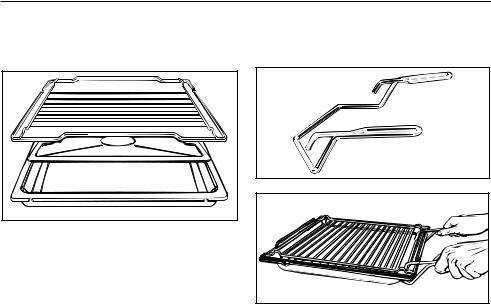
Description of the appliance
Anti-splash tray
(depending on model)
The anti-splash tray should be placed in the deep-sided grill pan when grilling or roasting.
The juices from the food being cooked collect under the anti-splash tray. This prevents them from spitting and making the oven dirty. The juices can then be used for making gravy and sauces.
Handle
(depending on model)
The handle makes it easier to take the baking tray, grill pan and rack out of the oven, or to put them into it.
The two prongs at the top go inside the pan, rack or tray and the U-shaped supports underneath.
9
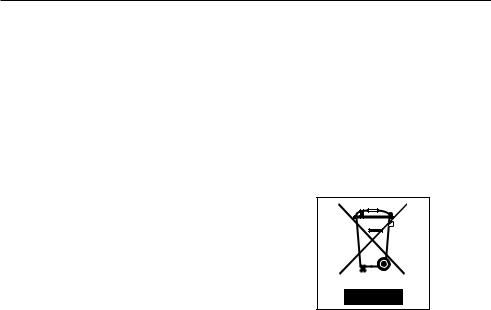
Caring for the environment
Disposal of the packing material
The transport and protective packing has been selected from materials which are environmentally friendly for disposal and can normally be recycled.
Ensure that any plastic wrappings, bags etc. are disposed of safely and kept out of the reach of babies and young children. Danger of suffocation!
Rather than just throwing these materials away, please ensure they are offered for recycling.
Disposal of your old appliance
Electrical and electronic appliances often contain materials which, if handled or disposed of incorrectly, could be potentially hazardous to human health and to the environment. They are, however, essential for the correct functioning of your appliance. Please do not therefore dispose of it with your household waste.
Please dispose of it at your local community waste collection / recycling centre and ensure that it presents no danger to children while being stored for disposal.
It should be unplugged or disconnected from the mains electricity supply by a competent person. Any plug must be rendered useless and the cable cut off directly behind it to prevent misuse. See the "Warning and Safety" section of this booklet for further details.
10

Warning and Safety instructions
This appliance complies with all relevant legal safety requirements. Improper use of the appliance can, however, present a risk of both personal injury and material damage.
To avoid the risk of accidents and damage to the appliance, please read these operating instructions carefully before installation and before using it for the first time. They contain important notes on installation, safety, operation and care of the appliance.
Keep these instructions in a safe place and pass them on to any future user.
Correct usage
This appliance is intended for domestic use to cook food, and in
particular to bake, roast, defrost, cook, dry fruit etc, and to grill.
Any other usage is at the owner’s risk and could be dangerous. The manufacturer cannot be held liable for damage caused by incorrect or improper use of the appliance.
The use of the appliance by the elderly or infirm or those who have
not used the appliance before should be supervised by a competent and responsible person to avoid the risk of injury.
This appliance is not a toy! To avoid the risk of injury, keep
children well away and do not let them play with it or use the controls. They will not understand the potential dangers posed by it. They should be supervised whenever you are working in the kitchen.
Older children may use the appliance only when its operation
has been clearly explained to them and they are able to use it safely, recognising the dangers of misuse.
Technical safety
Before connecting the appliance to the mains supply, make sure that
the voltage and frequency correspond to the rating on the data plate, otherwise the appliance could be damaged. Consult a competent person if in doubt.
The electrical safety of this appliance can only be guaranteed
when continuity is complete between it and an effective earthing system which complies with local and national safety regulations. It is most important that this basic safety requirement is present and regularly tested, and where there is any doubt the household wiring system should be inspected by a qualified electrician.
The manufacturer cannot be held liable for the consequences of an inadequate earthing system (e.g. electric shock).
11
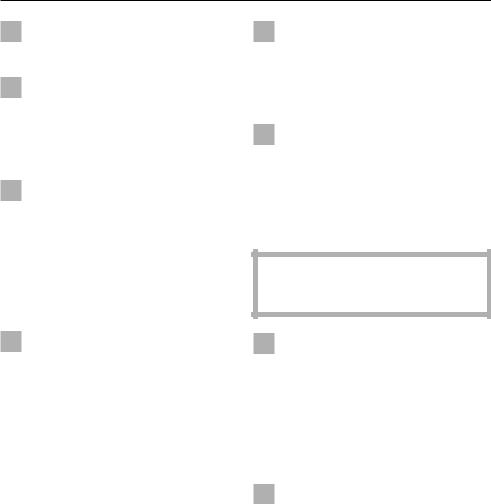
Warning and Safety instructions
The appliance must be built in before operation to ensure that no
electrical components are accessible.
Never open the casing of the appliance.
Tampering with electrical connections or components and mechanical parts is highly dangerous to the user and can cause operational faults.
Installation, maintenance and repairs may only be carried out by
a suitably qualified and competent person in accordance with national and local safety regulations.
Repairs and other work by unqualified persons could be dangerous. The manufacturer cannot be held liable for unauthorised work.
During installation, maintenance and repair work, the appliance
must be disconnected from the mains electricity supply. The appliance is only completely isolated from the electricity supply when:
–the mains fuse is withdrawn,
–or the screw-out fuse is removed (in countries where this is applicable),
–or it is switched off at the isolator.
Ensure that current is not supplied to the appliance until after maintenance or repair work has been carried out.
Do not connect the appliance to the mains electricity supply by an
extension lead.
Extension leads do not guarantee the required safety of the appliance (e.g. danger of overheating).
This equipment may only be used in mobile installations such as
ships, caravans, aircraft etc. if a risk assessment of the installation has been carried out by a suitably qualified engineer.
Use
Caution, danger of burning.
High temperatures are produced by the oven.
Great care should be taken to ensure that small children do not
touch the appliance when it is being used. Children’s skin is far more sensitive to high temperatures than that of adults.
External parts of the oven such as the door glass, handle vent and control panel can become quite hot.
Children should not be left alone or unattended in an area where an
oven is in use. They should never be allowed to sit or stand on any part of the oven or play with it.
Do not store items of interest to children in cabinets above an oven. Children climbing on to the oven to reach these could be seriously injured.
12

Warning and Safety instructions
Use oven gloves when placing food in the oven, turning or
removing it and when adjusting shelves etc in a hot oven.
When using "Conventional" heating or when grilling the element in the roof of the oven and the roof liner become very hot.
The oven door gets much hotter during pyrolytic operation than
during normal use.
Make sure children cannot touch the oven whilst a pyrolytic programme is running. Danger of burning.
Remove all accessories as well as the runners and any extra
accessories such as, for example, the baking carriage, or telescopic runners from the oven interior before starting the pyrolytic cleaning process. The high temperatures needed for pyrolysis will damage the accessories and cause irreparable damage to the baking carriage and telescopic runners.
Do not use plastic containers. These melt at high temperatures
and could damage the oven.
Do not heat up unopened tins or jars of food in the oven, as
pressure can build up and they may explode resulting in injury or damage.
Do not push pots and pans around on the oven floor, as this could
damage the surface.
Do not lean or sit on an open oven door, or place heavy items on it.
This could damage the appliance. The oven door can support a maximum load of 15 kg.
Make sure that nothing gets trapped between the door and the
oven.
Cover any food which is left in the oven to be kept hot. Any moisture
in the food could lead to corrosion damage in the oven. This also prevents the food from drying out.
If you wish to complete a cooking process using the residual heat in the oven, do not switch the appliance
off.
Leave the programme selector at the position set and select the lowest temperature.
Do not switch the appliance off until the food has been removed. Moisture in the oven could lead to condensation forming on the control panel and surrounding kitchen furniture and drops of moisture collecting under the worktop.
Condensation can:
–damage the housing unit / worktop.
–lead to corrosion in the oven.
On models fitted with a catalyser, it could also result in deposits remaining in the catalyser, causing an unpleasant smell to arise the next time the appliance is switched on.
13

Warning and Safety instructions
Bake larger frozen products, such as pizzas, on baking paper on the
rack itself or in the pizza pan (see "Extra accessories").
Placing them on the baking tray or in the grill pan can cause the metal to distort, and this distortion will increase with each subsequent use.
Frozen food such as oven chips or croquette potatoes can, however, be cooked on the baking tray or in the grill pan.
Never add water to food on a hot baking tray or grill pan or directly
onto food in a hot oven. The steam created could cause serious burns or scalding and the sudden change in temperature can damage the enamel.
Never line the floor of the oven with aluminium foil when using
Conventional CB or Bottom heat B or Intensive bake F, or place a dish, tin, baking tray or grill pan on the floor of the oven.
If using a grill pan made by a different manufacturer, make sure that there is a gap of at least 6 cm between the bottom of the pan and the floor of the oven.
If these instructions are not observed the bottom heat will be blocked. This can cause permanent damage to the floor of the oven.
Protective aluminium foil panels are available in retail outlets which are
supposed to protect the oven cavity from soiling and reduce the need for cleaning. If used, cooking and baking times will increase considerably. They can also cause damage to the appliance (e.g. by blocking the heat).
General notes
Never leave the appliance unattended when cooking with oil
or fats, as these are a fire hazard if allowed to overheat.
Do not use the oven to heat up the room. Due to the high temperatures
radiated, objects left near the oven could catch fire.
Always ensure that food is sufficiently cooked or reheated.
Many factors will affect the overall cooking time, including the size and amount of food, its temperature, changes to the recipe and the shape and size of cooking container. Some foods may contain micro-organisms which are only destroyed by thorough cooking at temperatures over 70 °C for a minimum of 10 minutes. Therefore when cooking or reheating foods, e.g. poultry, it is particularly important that food is fully cooked through. If in doubt select a longer cooking or reheating time.
It is important that the heat is allowed to spread evenly throughout the food being cooked. This can be achieved by stirring and/or turning the food during cooking.
14
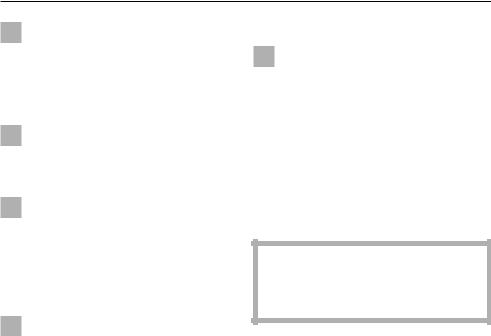
Warning and Safety instructions
When using kitchen appliances connected to sockets near the
oven, ensure that the cable cannot get trapped in a hot oven door, which could melt the cable insulation. Danger of electric shock.
Never use a steam cleaner to clean the appliance. The steam could
reach electrical components and cause a short circuit.
If using alcohol in your recipes, high temperatures can cause the
alcohol to vaporise and even to ignite on the hot heating elements.
Alcohol should be burnt off before the dish is placed in the oven to avoid this danger.
In countries where there are areas which may be subject to infestation
by cockroaches or other vermin, pay particular attention to keeping the appliance and its surroundings in a clean condition at all times. Any damage which may be caused by cockroaches or other vermin will not be covered by the appliance guarantee.
Disposal of your old appliance
Before throwing an old appliance away it must first be made
unusable. Switch off and disconnect it from the power supply, cut off the cable directly behind the appliance and render any plug useless. This should be done by a competent person. If connected to an isolator switch, disconnection should be carried out by an electrician to avoid the risk of accidents.
The manufacturer cannot be held liable for damage caused by non-compliance with these Warning and Safety instructions.
15

Safety feature
Door lock for pyrolytic mode
For safety reasons the door is automatically locked at the beginning of the pyrolytic programme.
At the end of the programme it will not be unlocked until the temperature inside the oven has dropped to below 280 °C.
If the Pyrolytic . cleaning programme has been started by mistake or if the process is interrupted, the door lock will be released:
–immediately if the temperature is below 280 °C.
The door can then be opened about 30 seconds later.
–not until the oven interior temperature is below 280 °C if the temperature inside the oven is higher than
280 °C.
16
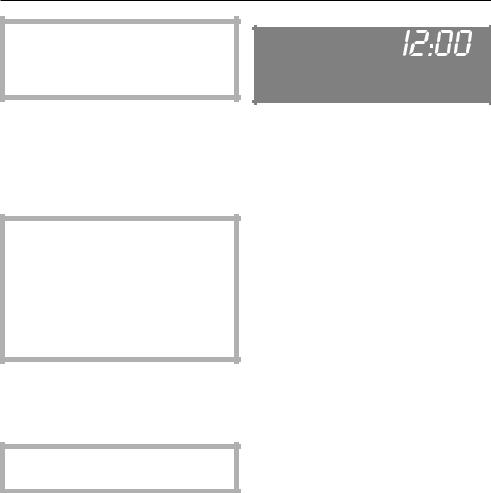
Before using for the first time
The oven is supplied with the controls pushed in.
They have to be released before the oven can be used.
After installation and before using the oven for the first time the clock has to be set.
When the oven is first switched on the clock will show 12:00 until you have set the correct time.
The display will go dark about 30 seconds after entering the time of day.
The time will continue to run in the background.
The time can also be set to show constantly in the display. See "Altering oven settings v– P I".
Set the time of day for the first time
The time can only be entered when the programme selector is at "0".
"I2:00" and the m (time of day) and V symbols will light up.
The clock has a 24 hour display.
m
V
^Press the multi-function selector gently.
"I2:00" and triangle Vunderneath the m symbol will start flashing.
^Turn the multi-function selector clockwise or anti-clockwise to display the hour required.
^Press the multi-function selector gently.
This confirms the hour and the minutes will then start to flash.
^Turn the multi-function selector clockwise or anti-clockwise to display the minutes required.
^Press the multi-function selector gently.
This confirms the minutes.
When the time has been entered, the display goes dark and the clock runs in the background.
The time will appear again in the display as soon as you press or turn the multi-function selector.
17

Before using for the first time
Cleaning and heating up for the first time
Before use, please remove
-any stickers from the floor of the oven, baking trays, grill pan etc.
-any cork spacers at the sides above the oven cavity.
-any protective foil from the oven front.
See "Cleaning and care" for more information.
Before using the oven for the first time
–take all accessories out of the oven and wash them.
–then heat the oven up once with nothing in it. New ovens have a slight smell on first use and this will dissipate the smells before you use it to cook any food.
^Before heating it up it is a good idea to wipe the oven out with a damp cloth first. This way any dust or bits of packaging that may have accumulated in the oven cavity during storage and unpacking will be removed.
^Press and release the programme selector and the multi-function selector.
^Turn the Programme selector to the Fan plus Ysetting.
U
V
The recommended temperature 160 °C will then appear in the display.
^Whilst the triangle Vis flashing underneath the Usymbol, use the multi-function selector to set the temperature to its highest setting (250 °C).
Once this setting has been confirmed
–the oven heating will switch on,
–and the actual temperature in the oven will show in the display.
Heat the empty oven up for at least an hour.
Please ensure that the kitchen is well ventilated during this operation. Close doors to other rooms to prevent the smell spreading throughout the house.
^Wait until the oven has cooled down to room temperature.
^Then wipe out the oven cavity with a solution of hot water and a mild detergent and then dry it thoroughly with a clean cloth.
Leave the oven door open until the oven interior is completely dry.
The timer can also be used to set the finish time. See "Entering a cooking duration - Switching off automatically".
18

Controls
The oven controls consist of:
–the Programme selector, for selecting oven functions with, e.g. Lighting H/v, Fan plus Y, Auto roast E, ...
–the Multi-function selector with press and turn mechanism for selecting oven functions which require input e.g. the time of day m, cooking durations g, ...
–the Display, where all changes and settings are visible.
Programme selector
The programme selector is used for selecting your cooking function.
It can be turned clockwise or anti-clockwise.
Display
U l m f g ) a
V
The bottom line shows the Symbols of functions where data can be changed.
The triangle Vwill appear in the display underneath the symbol of the function you have selected.
The top line shows:
–the time (time of day or a programmed cooking time).
–the oven temperature.
–the key symbol 0--§ will appear if the system lock is on or the programme selector is turned when a cooking programme has been locked using the programme lock.
–"EC for residual heat being used.
19
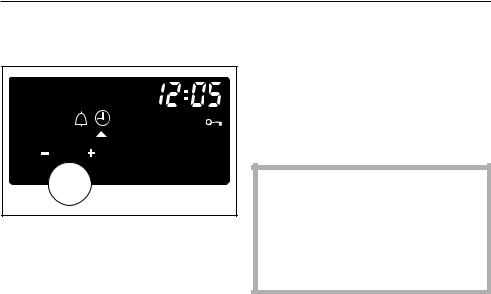
Controls
Multi-function selector with turn and press mechanism
To select a function, turn the multi-function selector until triangle V is underneath the required symbol in the display of the function you wish to make changes to.
Then press the multi-function selector to confirm your choice.
If triangle V
–is flashing, alterations can be made to the settings of the function selected.
–is lit up, the function will be displayed, but changes cannot be made to it.
Whilst triangle Vis flashing, use the multi-function selector to make any changes:
–Turning it clockwise, increases the value shown or engages the function,
–Turning it anti-clockwise, reduces the value or switches the function off.
The triangle Vwill flash for approx. 5 seconds.
Settings can only be changed while it is flashing.
If this period has elapsed you will have to call up the required symbol again.
Press the multi-function selector to confirm your choice.
See the chart for an overview of symbols in the display and their settings.
The display will change at a different rate depending on how quickly the selector is turned:
–in one minute increments
–in 10 minute increments or
–hour by hour.
20

Functions and symbols in the display
Different functions can be called up depending on the position of the programme selector.
This chart gives an overview of these settings.
|
|
|
|
Symbol |
Programme selector setting |
||
|
Position "0" |
Light H/v |
Function |
|
|
|
|
m |
Changing the time of |
– |
– |
|
day |
|
|
l |
Setting the minute |
Setting the minute |
Setting the minute |
|
minder |
minder |
minder |
a * |
Switch the system |
– |
Lock a cooking |
|
lock on or off |
|
programme |
|
|
|
|
p |
– |
– |
Change the oven |
|
|
|
temperature |
U* |
– |
– |
Switch Rapid heat off |
|
|
|
(applies to Fan plus |
|
|
|
Y, Auto roast E |
|
|
|
and Conventional |
|
|
|
heat CB only) |
|
|
|
|
f |
– |
– |
Enter a start time |
g |
– |
– |
Enter a duration |
|
|
|
|
) |
– |
– |
Enter a finish time |
|
|
|
|
*The symbol will only appear in the display if the respective function has been selected (see section "Altering oven settings v").
21
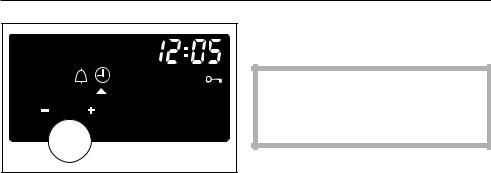
Operating sequence
Temperatures, times and other functions are controlled using two rotary dials:
Entries made are shown in the display.
To change a setting on the oven:
^Turn the programme selector to the required position.
^Then turn the multi-function selector.
All functions which can be set or changed will appear in the display.
^Turn the programme selector clockwise or anti-clockwise until triangle Vis underneath the required symbol in the display.
^Press the multi-function selector gently.
The function is now selected and the triangle Vunderneath required symbol will start to flash.
^Whilst the triangle Vis flashing, use the multi-function selector immediately to make any changes.
The triangle Vwill flash for appox. 5 seconds. If this input period has elapsed you will have to re-select the function.
^Press the multi-function selector gently.
This confirms your selection or any changes you have made.
This principle applies whenever you change a setting.
See "Altering the time of day" and "Using the oven" for examples which explain this principle in detail.
Note:
–Times entered are automatically saved after a short period of time without having to press the multi-function selector.
–Any changes to settings, however, have to be confirmed by pressing the multi-function selector.
22

Changing the time of day
In the following example the time of day is changed from 12:05 to 14:37.
^ Turn the function selector to "0".
l m
V
^Turn the multi-function selector (right hand dial) until triangle Vis underneath the m symbol in the display.
^Press the multi-function selector gently.
The hour and the triangle Vwill start flashing underneath the m symbol.
m
V
^Turn the multi-function selector until "14 shows in the display.
^Press the multi-function selector gently.
This confirms the hour and the minutes will then start to flash.
m
V
^Turn the multi-function selector until "37" shows in the display.
^Press the multi-function selector gently.
This confirms the minutes.
The symbols go out in a couple of seconds. The time set is now stored in memory.
If the display is set to show the time, the new time of day will show in the display.
To switch the display on or off see "Altering oven settings v– P I".
The current time of day will reappear even after a power cut.
The appliance stores this information for approx. 200 hours. After that "12:00" will flash in the display as it did when first switched on.
23

To set the minute minder
The minute minder can be used to time any activity in the kitchen, e.g. boiling eggs.
You can enter a time of up to a maximum of 12 hours.
You can set the minute minder at the same time as another timed programme, e.g. as a reminder to stir a dish or add seasoning etc.
At the end of the time set for the minute minder
–a buzzer will sound fives times in succession.
The standard default setting can be changed if you wish. See "Altering oven settings v– P 2 and P 3".
–the l symbol flashes for approx. 1 minute.
To set the minute minder
^Turn the multi-function selector until triangle Vis underneath the l symbol in the display.
^Press the multi-function selector gently.
l
V
"0:00" appears in the display.
^Whilst triangle Vis flashing, enter the required duration in hours and minutes using the multi-function selector.
The time entered counts down in minutes until the last minute, which counts down in seconds.
The l symbol continues to be visible as a reminder that the minute minder is being used.
As long as the l symbol is selected the minute minder time will be visible counting down in the display.
To cancel the time set for the minute minder
^Call up the l symbol.
Make sure the triangle is flashing underneath the symbol.
^Whilst triangle Vis flashing, set the minute minder time to "0:00" using the multi-function selector.
24

Description of the oven systems
Fan plus Y |
Auto roast E |
This system works by the circulation of heated air.
A fan situated in the back wall of the oven draws in the air, heats it over a ring element and blows it back into the oven cavity through the carefully spaced openings in the back panel.
The oven does not usually need to be pre-heated as the heated air reaches the food straight away.
Exception: Pre-heating may be necessary for foods which cook in less than 20 minutes and for foods such as puff pastry and yeast mixtures where instant heat is required to make them rise quickly.
When using Fan plus, you can bake and roast on different levels at the same time.
Lower temperatures can be used than with Conventional top and bottom heating, as the Fan plus system circulates the heated air throughout the oven.
The oven heats initially to a high temperature (230 °C) which seals the meat to keep it succulent and tasty. As soon as this temperature has been reached, the oven temperature automatically drops back down to the pre-selected setting.
Intensive bake F
This method combines Fan plus with Bottom heat. It is particularly useful for dishes that require a moist topping and crisp base like pizza and quiche lorraine.
Conventional (top and bottom heat) CB
With the conventional method of heating, radiant heat is directed onto the food from above and below. It is useful where a fairly long cooking time is required and a deep colour and good rise are needed.
It is usually necessary to pre-heat the oven when using this method.
25

Description of the oven systems
Gentle bake ö
Gentle bake uses the fan heat element and the fan.
It is suitable for bakes and gratins where a crispy finish is required.
Grill m
Pre-heat the grill for at least 5 minutes with the oven door closed before grilling.
The inner part of the upper heating element acts as the grill. This will glow red for a few minutes after being switched on, and it is then ready for use.
Grill with the oven door closed.
Use this setting for small quantities of food.
Grill - full n
Pre-heat the grill for at least 5 minutes with the oven door closed before grilling.
The entire upper heating element acts as the grill.
This method is particularly good for grilling large quantities of food using the grill pan to its full extent.
Grill with the oven door closed.
Fan grill N
Pre-heat the grill for at least 5 minutes with the oven door closed before grilling.
The hot air from the grill is distributed over the food by the fan on the back
wall of the oven. This enables a lower temperature to be selected than for conventional grilling.
Grill with the oven door closed.
Pyrolytic cleaning .
In this mode the oven cleans itself.
The oven is heated up to approx. 460 °C and any residual soiling in the oven interior is burnt off by the high temperatures.
This oven offers three programme durations for pyrolytic cleaning.
After the cleaning process any pyrolytic debris (e.g. ash) can be easily wiped out.
26
